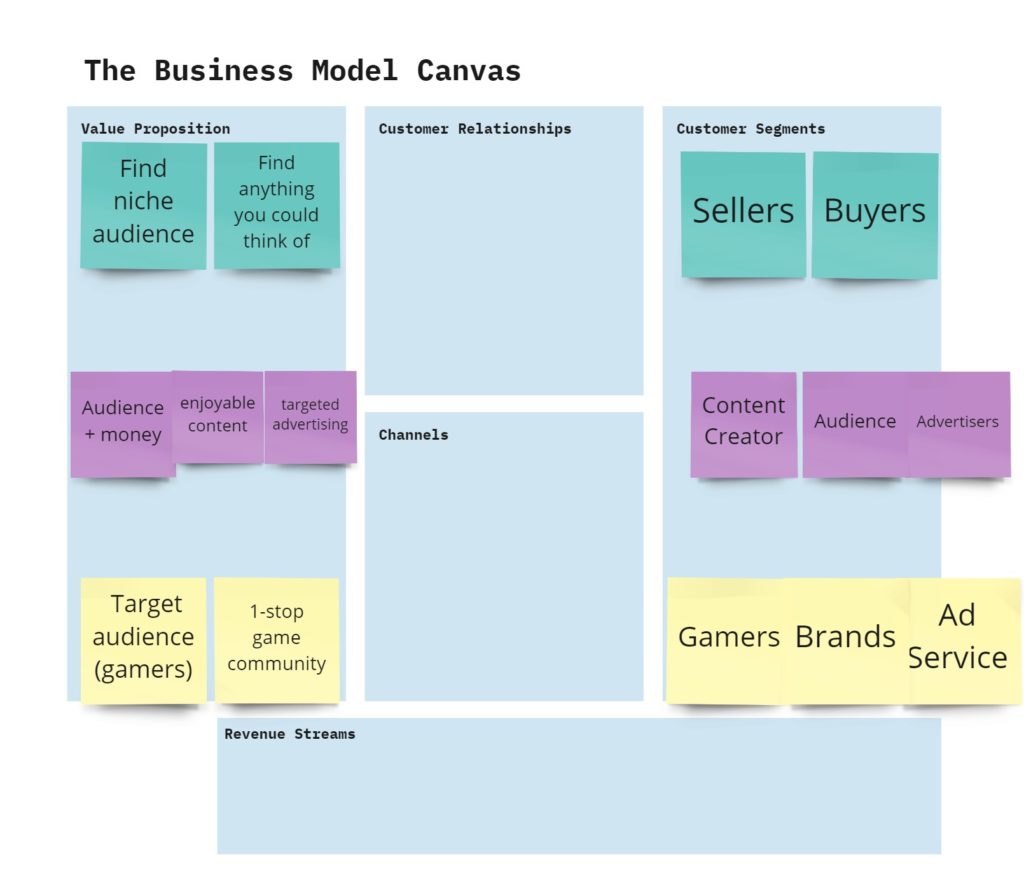
We began class by visiting our customers on the Business Model Canvas again. Your business model may have one product, but that product may have multiple, and very different, customer segments. Those segments may have different value propositions, channels and relationships.
We started with a simple example of PDI’s markets for CG – broadcast graphics, advertising, and film effects. Each market had a different group of customers who needed to be approached and managed in unique ways. From there we looked at four other models (there are many others, too):
- Ad supported businesses – If the user isn’t paying, you have more than one customer. For an ad supported business, you need to provide a product to the users (one customer segment), and provide the users’ attention to the advertisers (another customer segment). The value proposition, and the product itself, is very different for those two customers. And without a critical mass of users, you have no ad space to sell.
- Marketplaces (eBay, Etsy, …) – Two symbiotic but unique customers: buyers and sellers. As the marketplace provider, you need to have a critical mass of each to attract the other. A good reason to start with a very niche product. In some niche markets, like collectables, the buyers and sellers may be the same group of people, making your job easier.
- Platforms (mobile devices, game consoles, …) – Two types of users on your platform: the content creators and the users of that content. Platform providers will either develop initial content themselves or incentivize others to create it. Without enough content at launch, users may ignore the platform. Some platforms are fortunate to have “killer content” that is a strong enough single title to justify the purchase of the platform.
- Distribution platforms (YouTube, Instagram, Twitter,…) – These platforms may have three or more types of customers. Creators provide the content for the platform (customer one) and viewers consume the content (customer two). The platform will incentivize creators through revenue sharing, exposure, or other models. The platform will generate revenue through advertising (customer three) or subscriptions. Viewers can also be segmented into participants (who contribute to the community through likes, comments, ratings, etc.) and lurkers (who just consume). Participants and lurkers also have different value propositions for using the platform. (Wikipedia has a nice breakdown on the 1% rule, and Tubular Labs shares some YouTube rules of thumb.)

The Left Side of the BMC
After a short break we rejoined to talk about the left side of the Business Model Canvas. This is where the work is actually done. In Miro we visited the three Key blocks and got a feel for the variety of different areas we would need to pay attention to as an entrepeneur. More details on these blocks are in the Business Model Generation book. We’ll talk more about the Cost Structure when we get into financials next week.

Accelerators
Luckily accelerators can give us a boost in this part of our business. They specialize in helping you get your product launched and finding you first round investors. As a part of that service, they help you with most of the items in the Key blocks – either by providing that service for you (like facilities) or connecting you to others who can help (lawyers for your IP and corporate governance, mentors, product area specialists, and the network of their prior alums). For all this help, they become a Key Partner for you, usually in the form of equity.
We talked about five specific examples in class. These organizations all have multiple programs running around the world, and there are many similar companies in almost every major urban area now. (Be careful, though. Be sure to do your homework and check backgrounds and reputations.)
Up Next
Next Tuesday will be your team customer presentations. Then we’ll start digging into financials and financial modeling.